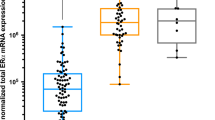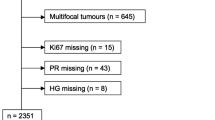Abstract
The estrogen receptor (ER) is a key predictive biomarker in the treatment of breast cancer. There is uncertainty regarding the use of hormonal therapy in the setting of weakly positive ER by immunohistochemistry (IHC). We report intrinsic subtype classification on a cohort of ER weakly positive early-stage breast cancers. Consecutive cases of breast cancer treated by primary surgical resection were retrospectively identified from 4 centers that engage in routine external proficiency testing for breast biomarkers. ER-negative (Allred 0 and 2) and ER weakly positive (Allred 3–5) cases were included. Gene expression profiling was performed using qRT-PCR. Intrinsic subtype prediction was made based upon the PAM50 gene expression signature. 148 cases were included in the series: 60 cases originally diagnosed as ER weakly positive and 88 ER negative. Of the cases originally assessed as ER weakly positive, only 6 (10 %) were confirmed to be of luminal subtype by gene expression profiling; the remaining 90 % of cases were classified as basal-like or HER2-enriched subtypes. This was not significantly different than the fraction of luminal cases identified in the IHC ER-negative cohort (5 (5 %) luminal, 83(95 %) non-luminal). Recurrence-free, and overall, survival rates were similar in both groups (p = 0.4 and 0.5, respectively) despite adjuvant hormonal therapy prescribed in the majority (59 %) of weakly positive ER cases. Weak ER expression by IHC is a poor correlate of luminal subtype in invasive breast cancer. In the setting of highly sensitive and robust IHC methodology, cutoffs for ER status determination and subsequent systemic therapy should be revisited.


Similar content being viewed by others
References
Beatson GT (1896) On the treatment of inoperable cases of carcinoma of the mamma: suggestions for a new method of treatment, with illustrative cases. Lancet 148(3803):162–165
Wolff AC, Dowsett M (2011) Estrogen receptor: a never ending story? J Clin Oncol 29(22):2955–2958
McGuire WL (1973) Estrogen receptors in human breast cancer. J Clin Invest 52(1):73–77
Early Breast Cancer Trialists’ Collaborative Group (2011) Relevance of breast cancer hormone receptors and other factors to the efficacy of tamoxifen: patient-level meta-analysis of randomized trials. Lancet 378(9793):771–784
Dowsett M (2006) Estrogen receptor: methodology matters. J Clin Oncol 24(36):5626–5628
Gown AM (2004) Unmasking the mysteries of antigen or epitope retrieval and formalin fixation. Am J Clin Pathol 121(2):172–174
Sabattini E, Bisgaard K, AScani S, Poggi S, Piccioli M, Ceccarelli C, Pieri F, Fraternali-Orcioni G, Pileri SA (1998) The EnVision++ system: a new immunohistochemical method for diagnostics and research. Critical comparison with the APAAP, ChemMate, CSA, LABC, and SABC techniques. J Clin Pathol 51(7):506–511
Cheang MC, Treaba DO, Speers CH, Olivotto IA, Bajdik CD, Chia SK, Goldstein LC, Gelmon KA, Huntsman D, Gilks CB, Nielsen TO, Gown AM (2006) Immunohistochemical detection using the new rabbit monoclonal antibody SP1 of estrogen receptor in breast cancer is superior to mouse monoclonal antibody 1D5 in predicting survival. J Clin Oncol 24(36):5637–5644
Terry J, Tolakovic EE, Garrat J et al (2009) Implementation of a Canadian external quality assurance program for breast cancer biomarkers: an initiative of Canadian Quality Control in immunohistochemistry (cIQc) and Canadian Association of Pathologists (CAP) National Standards Committee/immunohistochemistry. Appl Immunohistochem Mol Morphol 17(5):375–382
Harvey JM, Clark GM, Osborne CK, Allred DC (1999) Estrogen receptor status by immunohistochemistry is superior to the ligand-biding assay for predicting response to adjuvant endocrine therapy in breast cancer. J Clin Oncol 17(5):1474–1481
Hammond ME, Hayes DF, Dowsett M et al (2010) American Society of Clinical Oncology/College of American Pathologists guideline recommendations for immunohistochemical testing of estrogen and progesterone receptors in breast cancer. J Clin Oncol 28(16):2784–2795
Nadji M, Gomez-Fernandez C, Ganjei-Azar P, Morales AR (2005) Immunohistochemistry of estrogen and progesterone receptors reconsidered: experience with 5993 breast cancers. Am J Clin Pathol 123(1):21–27
Khoshnoud MR, Löfdahl B, Fohlin H et al (2011) Immunohistochemistry compared to cytosol assays for determination of estrogen receptor and prediction of the long-term effect of adjuvant tamoxifen. Breast Cancer Res Treat 126(2):421–430
Iwamoto T, Booser D, Valero V et al (2012) Estrogen receptor (ER) mRNA and ER-related gene expression in breast cancers that are 1–10 % ER-positive by immunohistochemistry. J Clin Oncol 30(7):729–734
Allred DC, Carlson RW, Berry DA et al (2009) NCCN task force report: estrogen receptor and progesterone receptor testing in breast cancer by immunohistochemistry. J Natl Compr Canc Netw 7(S6):s1–s21
Rhodes A, Jasani B, Barnes DM et al (2000) Reliability of immunohistochemical demonstration of estrogen receptors in routine practice: inter-laboratory variance in the sensitivity of detection and evaluation of scoring systems. J Clin Pathol 53:125–130
Parker RL, Huntsman DG, Lesack DW et al (2002) Assessment of inter-laboratory variation in immunohistochemical determination of estrogen receptor using a breast cancer tissue microarray. Am J Clin Pathol 117:723–728
Cm Perou, Sorlie T, Eisen MB et al (2000) Molecular portraits of human breast tumours. Nature 406(6797):747–752
Sørlie T, Perou CM, Tibshirani R et al (2001) Gene expression patterns of breast carcinomas distinguish tumor subclasses with clinical implications. Proc Natl Acad Sci USA 98(19):10869–10874
Sorlie T, Tibshirani R, Parker J et al (2003) Repeated observation of breast tumor subtypes in independent gene expression data sets. Proc Natl Acad Sci 100:8418–8423
Hu Z, Fan C, Oh DS et al (2006) The molecular portraits of breast tumors are conserved across microarray platforms. BMC Genom 7:96
Won JR, Gao D, Chow C et al (2013) A survey of immunohistochemical biomarkers for basal-like breast cancer against a gene expression profile gold standard. Mod Pathol 26(11):1438–1450
Park Y, Moryama A, Kithara T, Yoshida Y, Urita T, Kato R (2012) Triple-negative breast cancer and poly(ADP-ribose) polymerase inhibitors. Anticancer Agents Med Chem 12(6):672–677
Parker JS, Mullins M, Cheang MC et al (2009) Supervised risk predictor of breast cancer based on intrinsic subtypes. J Clin Oncol 27(8):1160–1167
Chia SK, Bramwell VH, Tu D et al (2012) A 50-gene intrinsic subtype classifier for prognosis and prediction of benefit from adjuvant tamoxifen. Clin Cancer Res 18(16):4465–4472
Perez T, Makretsov N, Garatt J, Torlakovic E, Gilks CB, Mallett S. Modeling Canadian quality control test program for steroid hormone receptors in breast cancer: diagnostic accuracy study. Appl Immunohistochem Mol Morphol [Epub ahead of print] PMID2620083
Mullins M, Perreard L, Quackenbush JF et al (2007) Agreement in breast cancer classification between microarray and quantitative reverse transcription PCR from fresh-frozen and formalin-fixed, paraffin-embedded tissues. Clin Chem 53:1273–1279
Bernard PS (2012) Personalized medicine for breast cancer. In: Ginsburg G (ed) Genomic and personalized medicine, 2nd edn. Elsevier, Amsterdam, pp 707–713
Perreard L, Fan C, Quackenbush JF et al (2006) Classification and risk stratification of invasive breast carcinomas using a real-time quantitative RT-PCR assay. Breast Cancer Res 8:R23
Nielsen TO, Parker JS, Leung S et al (2010) A comparison of PAM50 intrinsic subtyping with immunohistochemistry and clinical prognostic factors in tamoxifen-treated estrogen receptor positive breast cancer. Clin Cancer Res 16(21):5222–5232
Lin CM, Jaswal J, Vandenberg T, Tuck A, Brackstone M (2013) Weakly hormone receptor-positive breast cancer and use of adjuvant hormonal therapy. Curr Oncol 20(6):e612–e613
Prabhu JS, Korlimarla A, Desai K et al (2014) A majority of low (1–10%) ER positive breast cancers behave like hormone receptor negative tumors. J Cancer 5(2):156–165
Deyarmin B, Kane JL, Valente AL, van Laar R, Gallagher C, Shriver CD, Ellseworth RE (2013) Effect of ASCO/CAP guidelines for determining ER status on molecular subtype. Ann Surg Oncol 20(1):87–93
Rakha EA, Lee AH, Roberts J, Villena Salinas NM, Hodi Z, Ellis IO, Reis-Filho JS (2012) Low-estrogen receptor-positive breast cancer: the impact of tissue sampling, choice of antibody, and molecular subtyping. J Clin Oncol 30(23):2929–2930
Acknowledgments
The authors would like to thank the Canadian Breast Cancer Foundation—British Columbia/Yukon chapter for their support of this research. This work was supported by a grant from the Canadian Breast Cancer Foundation (British Columbia and Yukon).
Author information
Authors and Affiliations
Corresponding author
Additional information
B. S. Sheffield and Z. Kos have contributed equally to this work.
Rights and permissions
About this article
Cite this article
Sheffield, B.S., Kos, Z., Asleh-Aburaya, K. et al. Molecular subtype profiling of invasive breast cancers weakly positive for estrogen receptor. Breast Cancer Res Treat 155, 483–490 (2016). https://doi.org/10.1007/s10549-016-3689-z
Received:
Accepted:
Published:
Issue Date:
DOI: https://doi.org/10.1007/s10549-016-3689-z




